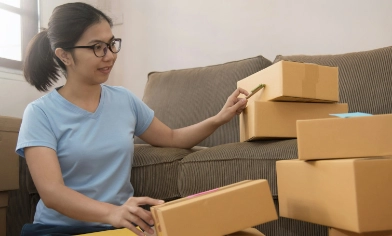The online seller opportunity
Selling items online is getting more and more popular. It’s a great way for people to both declutter their homes and make some extra cash.
A 2025 study commissioned by Post Office1 found that people surveyed make an average of £716 per year from selling items online. Many of these sell clothes online, but there’s money to be made in lots of other categories too.
Why choose to sell on eBay
eBay was one of the first digital marketplaces and launched over 20 years ago. Today it’s available in over 150 countries, with more than 100 million visitors from across the world every month. This makes it an ideal platform to introduce your products to a huge global audience. Plus, it suits everyone from first timers to full-time, established online sellers.
How to sell on eBay UK?
Before you get started with an eBay account. it’s a good idea to work out how often and how much you want to sell. Then you can choose between a personal or business account. Both types of account are free to set up. Depending on the account type you set up and how many items you list, you may be charged a listing fee.
Personal account
This is ideal if you only intend to sell the occasional item. Perfect for when you want to have a clear out of your clutter and make a bit of cash on the side. It may also suit if you’re starting a side hustle selling online, to supplement another income.
Business account
If you’re thinking about growing your side hustle or making selling your full-time job, a business account is the option to go for. And if you have an existing company, this type of account lets you use your legal business name and keep your finances separate. This can make it much easier to manage your accounting and taxes.
If you choose to become a business seller, eBay has lots of resources and helpful information in its SellerCentre.
Choose what you’re going to sell
If you’re planning to run a business through an online marketplace, it pays to do your research upfront. Start by finding a niche or product category you want to sell in. Then research popular items, the strength of demand, and current market trends help you home in on your chosen area.
eBay has its own selling insights tool called Product Research. It can help you to quickly and easily research what other sellers are offering, and how their products are performing. It can even help you improve your own listings to sell even more effectively.
Ideas of what to sell on eBay
One of the joys of online marketplaces is the sheer breadth of choice and diversity of items you can buy and sell there. But to be really successful, it’s probably best to narrow down what you want to sell. What are your passions? The things you’re most interested are likely to drive your best sales.
Most people who sell items online tend to sell second-hand clothes (55%). Other popular items include new clothes or shoes (32%), games and toys (29%), children’s clothes or toys (25%) and second-hand tech (24%).
If you’re unsure where to start, these categories might help.
- Used or vintage items: great if you have lots of things to clear out from your home. Also ask family and friends for unwanted, pre-loved items. Or visit flea markets, car boot fairs and vintage shops to source pre-owned clothing, electronics, homewares and collectables
- Brand new products: you can get these direct from wholesalers or manufacturers and become the liaison between them and their customers. This option works particularly well for electronics, fashion and handmade items
- Unique crafts: one-off or small batch products such as handmade jewellery, artwork and personalised items are another popular area with sellers and customers alike
- Rare and collectable items: online marketplaces are a great place for collectors to find those rare, must-have treasures. Consider selling antiques, rare books, period jewellery and vintage toys
- Dropshipping: this is an increasingly lucrative way to sell and is very popular with online sellers. You partner directly with suppliers to make the sales, but they hold the inventory of the items you’re selling. This means you don’t have to find storage space or worry about processing and posting once you’ve made a sale. When a sale’s completed, the product’s shipped directly from the supplier to the buyer
Making the most of your sales
You’ve made the decision of what to sell, so how best to market your products? Here are a few tips to make your sales as successful as possible.
Optimise your listings
- Make product descriptions clear: List each item’s key features or benefits in clear, concise language, and check for any spelling or grammatical errors before posting. eBay also features an AI tool to help generate listing copy to make this easier for users
- Use high-quality imagery: Try to take your photos in good lighting conditions and against a neutral background. You can add up to 24 photos per listing, perfect for showing multiple angles
- List each item’s condition accurately: Depending on the category your product comes under, you’ll have a choice of item conditions to select from. You can find more information on eBay’s help pages
- Be clear about postage: If you’re asking buyers to pay any extra postage costs, let them know in your listing. Or offer free postage and packing as an added incentive to buy. There’s lots more information on postage options in eBay’s customer service pages
Offer a great shopping experience
- Set realistic prices: This applies to both your products and postage fees. Research your competitors to see the level of pricing they use for items similar those you’re selling
- Choose how you’ll sell: Consider whether to use an auction-style or fixed-price listing. Auctions can create a sense of urgency to bid. Fixed-price listings let customers know exactly what they’ll be paying upfront
- Always give the highest levels of service: Reply to customer enquiries and questions promptly and professionally. Give as much information as you can. Be as accurate as possible. Positive reviews will help you to build a strong seller reputation and encourage repeat and new customers alike
- Set up shop: If your sales are soaring, consider setting up an eBay Shop. There’s a monthly subscription fee, but it means you can personalise your online presence. This can help your customers find you more easily and grow your business at the same time
How do you post things on eBay?
You’ve made a successful sale, now it’s time to post your product to your customer. There are lots of posting options out there to choose from, including through Post Office.
If you have a personal eBay account, you’ll most likely be using Simple Delivery. This means the buyer pays for the postage and you’ll be sent a prepaid postage label. You can print this yourself or ask the Post Office team to print it from a QR code. Our branches should accept all parcels, as long as they’re within the service’s maximum weight and dimensions (20 kg and 61 cm x 46cm x 46cm).
If you’re a business sender, it’s easy to work out the cost to post items you’ve sold on eBay with our Parcels Online cost calculator. Compare UK and international delivery services from our partner couriers and pay online. Then drop off your parcels at a participating branch whenever it suits you.
If you post regularly or in bulk, consider a Drop & Go account. It’s free to sign up online or in branch. Just prepare your parcels in advance, drop them off and go. There’s no need to queue, weigh or label them. We’ll process them that day and charge your prepaid account.
What’s more, you can link your eBay account to both Parcels Online and Drop & Go. This makes bulk shipping faster and easier, so you can spend more time selling and less time posting.
Need some help?
Pop into a branch and talk to the postmaster or team there about the best service for sending what you’ve sold. Every branch in the UK offers services from Royal Mail and Parcelforce Worldwide. And a growing number now offer services from DPD, Evri or both too. Find your nearest branch
Key takeaways
- eBay is a popular online marketplace with millions of buyers, making it a great place to sell both second-hand and new items
- You can choose between a personal account for occasional selling or a business account if you want to sell regularly and professionally
- Research popular products, use clear descriptions and take high-quality photos to help increase your sales
- Convenient Post Office shipping options like Parcels Online and Drop & Go make it easier to send items you’ve sold quickly




















